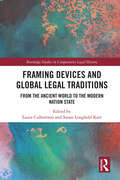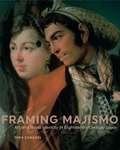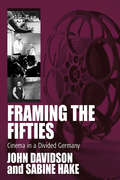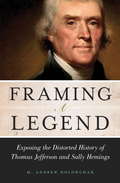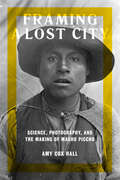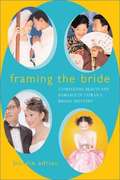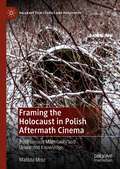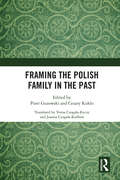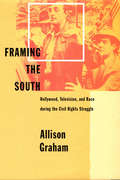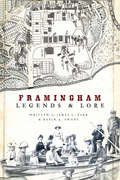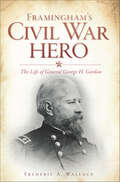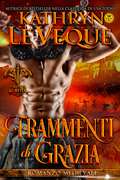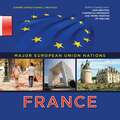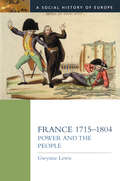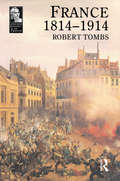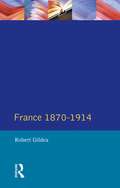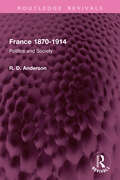- Table View
- List View
Framing Devices and Global Legal Traditions: From the Ancient World to the Modern Nation State (Routledge Studies in Comparative Legal History)
by Laura Culbertson Susan Longfield KarrThis collection explores prefaces, prologues, paratexts, and other types of framing devices. Across world history, these devices have introduced the law, articulated its context and audience, identified the basis of legal and moral authority, critiqued existing conditions, or even tried to "restore" something that never was. Scribes, lawmakers, and legal theorists also used frames to position the law in time and space, purporting to define populations and their identities. Despite the ubiquity and complexity of these phenomena, few studies have drawn out methods for studying their role in constructing, fortifying, or reimagining legal frameworks within legal cultures or traditions. This volume offers new ways to consider the significance of framing apparatuses regarding how and why they are created, remembered, forgotten, utilized, and recovered within legal traditions. The studies range from the ancient world to the modern nation-state system, aiming to explore the intersections and collisions between juridical and political interpretation practices.The book will be of interest to academics and researchers in the areas of legal history, comparative law, legal cultures and traditions, legal theory, jurisprudence, constitutional law and legislative drafting.
Framing Female Lawyers: Women on Trial in Film
by Cynthia LuciaAs real women increasingly entered the professions from the 1970s onward, their cinematic counterparts followed suit. Women lawyers, in particular, were the protagonists of many Hollywood films of the Reagan-Bush era, serving as a kind of shorthand reference any time a script needed a powerful career woman. Yet a close viewing of these films reveals contradictions and anxieties that belie the films' apparent acceptance of women's professional roles. In film after film, the woman lawyer herself effectively ends up "on trial" for violating norms of femininity and patriarchal authority.<P><P>In this book, Cynthia Lucia offers a sustained analysis of women lawyer films as a genre and as a site where other genres including film noir, maternal melodrama, thrillers, action romance, and romantic comedy intersect. She traces Hollywood representations of female lawyers through close readings of films from the 1949 Adam's Rib through films of the 1980s and 1990s, including Jagged Edge, The Accused, and The Client, among others. She also examines several key male lawyer films and two independent films, Lizzie Borden's Love Crimes and Susan Streitfeld's Female Perversions. Lucia convincingly demonstrates that making movies about women lawyers and the law provides unusually fertile ground for exploring patriarchy in crisis. This, she argues, is the cultural stimulus that prompts filmmakers to create stories about powerful women that simultaneously question and undermine women's right to wield authority.
Framing Formalism: Riegl's Work (Critical Voices in Art, Theory and Culture)
by Richard WoodfieldFirst Published in 2001. Routledge is an imprint of Taylor & Francis, an informa company.
Framing Majismo: Art and Royal Identity in Eighteenth-Century Spain
by Tara ZanardiMajismo, a cultural phenomenon that embodied the popular aesthetic in Spain from the second half of the eighteenth century, served as a vehicle to “regain” Spanish heritage. As expressed in visual representations of popular types participating in traditional customs and wearing garments viewed as historically Spanish, majismo conferred on Spanish “citizens” the pictorial ideal of a shared national character.In Framing Majismo, Tara Zanardi explores nobles’ fascination with and appropriation of the practices and types associated with majismo, as well as how this connection cultivated the formation of an elite Spanish identity in the late 1700s and aided the Bourbons’ objective to fashion themselves as the legitimate rulers of Spain. In particular, the book considers artistic and literary representations of the majo and the maja, purportedly native types who embodied and performed uniquely Spanish characteristics. Such visual examples of majismo emerge as critical and contentious sites for navigating eighteenth-century conceptions of gender, national character, and noble identity. Zanardi also examines how these bodies were contrasted with those regarded as “foreign,” finding that “foreign” and “national” bodies were frequently described and depicted in similar ways. She isolates and uncovers the nuances of bodily representation, ultimately showing how the body and the emergent nation were mutually constructed at a critical historical moment for both.
Framing Majismo: Art and Royal Identity in Eighteenth-Century Spain
by Tara ZanardiMajismo, a cultural phenomenon that embodied the popular aesthetic in Spain from the second half of the eighteenth century, served as a vehicle to “regain” Spanish heritage. As expressed in visual representations of popular types participating in traditional customs and wearing garments viewed as historically Spanish, majismo conferred on Spanish “citizens” the pictorial ideal of a shared national character.In Framing Majismo, Tara Zanardi explores nobles’ fascination with and appropriation of the practices and types associated with majismo, as well as how this connection cultivated the formation of an elite Spanish identity in the late 1700s and aided the Bourbons’ objective to fashion themselves as the legitimate rulers of Spain. In particular, the book considers artistic and literary representations of the majo and the maja, purportedly native types who embodied and performed uniquely Spanish characteristics. Such visual examples of majismo emerge as critical and contentious sites for navigating eighteenth-century conceptions of gender, national character, and noble identity. Zanardi also examines how these bodies were contrasted with those regarded as “foreign,” finding that “foreign” and “national” bodies were frequently described and depicted in similar ways. She isolates and uncovers the nuances of bodily representation, ultimately showing how the body and the emergent nation were mutually constructed at a critical historical moment for both.
Framing Mary: The Mother of God in Modern, Revolutionary, and Post-Soviet Russian Culture (NIU Series in Slavic, East European, and Eurasian Studies)
by Adams Vera Amy Singleton ShevzovDespite the continued fascination with the Virgin Mary in modern and contemporary times, very little of the resulting scholarship on this topic extends to Russia. Russia's Mary, however, who is virtually unknown in the West, has long played a formative role in Russian society and culture. Framing Mary introduces readers to the cultural life of Mary from the seventeenth century to the post-Soviet era. It examines a broad spectrum of engagements among a variety of people—pilgrims and poets, clergy and laity, politicians and political activists—and the woman they knew as the Bogoroditsa. In this collection of well-integrated and illuminating essays, leading scholars of imperial, Soviet, and post-Soviet Russia trace Mary's irrepressible pull and inexhaustible promise from multiple disciplinary perspectives. Focusing in particular on the ways in which both visual and narrative images of Mary frame perceptions of Russian and Soviet space and inform discourse about women and motherhood, these essays explore Mary's rich and complex role in Russia's religion, philosophy, history, politics, literature, and art. Framing Mary will appeal to Russian studies scholars, historians, and general readers interested in religion and Russian culture.
Framing The Fifties
by Sabine Hake John DavidsonThe demise of the New German Cinema and the return of popular cinema since the 1990s have led to a renewed interest in the postwar years and the complicated relationship between East and West German cinema in particular. A survey of the 1950s, as offered here for the first time, is therefore long overdue. Moving beyond the contempt for "Papa's Kino" and the nostalgia for the fifties found in much of the existing literature, this anthology explores new uncharted territories, traces hidden connections, discovers unknown treasures, and challenges conventional interpretations. Informed by cultural studies, gender studies, and the study of popular cinema, this anthology offers a more complete account by focusing on popular genres, famous stars, and dominant practices, by taking into account the complicated relationships between East vs. West German, German vs. European, and European vs. American cinemas; and by paying close attention to the economic and political conditions of film production and reception during this little-known period of German film history.
Framing a Legend
by M. Andrew HolowchakA penetrating critical perspective on the question of Thomas Jefferson's paternity that will make you rethink recent conventional wisdom. It is accepted by most scholars that Jefferson had a lengthy affair with his slave Sally Hemings and fathered at least one of her children, a conclusion based on a 1998 DNA study published in Nature and on the work of historian Annette Gordon-Reed. Framing a Legend argues compellingly that the DNA evidence is inconclusive and that there are remarkable flaws in the leading historical scholarship purporting to show such a liaison. It critically examines well-known books by Fawn Brodie, Annette Gordon-Reed, and Andrew Burstein. Among other defects in these authors' works, Holowchak notes selective use of evidence, ungrounded speculation, tendentious psychologizing, and unpersuasive argumentation. He delves into what we know about Thomas Jefferson's character by showing that the historical facts do not suggest any romantic interest on Jefferson's part in his female slaves. Turning to the genetic evidence, Holowchak points out that, though DNA analysis indicates the presence of a Y-chromosome from some Jefferson male in the Hemings family line, it is unwarranted to conclude that this must have come from Thomas Jefferson. Finally, he discusses Jefferson's racial attitudes and says that they argue against any liaison with Sally Hemings.
Framing a Lost City: Science, Photography, and the Making of Machu Picchu (Joe R. and Teresa Long Series in Latin American and Latino Art and Culture)
by Amy Cox HallWhen Hiram Bingham, a historian from Yale University, first saw Machu Picchu in 1911, it was a ruin obscured by overgrowth whose terraces were farmed a by few families. A century later, Machu Picchu is a UNESCO world heritage site visited by more than a million tourists annually. This remarkable transformation began with the photographs that accompanied Bingham’s article published in National Geographic magazine, which depicted Machu Picchu as a lost city discovered. Focusing on the practices, technologies, and materializations of Bingham’s three expeditions to Peru (1911, 1912, 1914–1915), this book makes a convincing case that visualization, particularly through the camera, played a decisive role in positioning Machu Picchu as both a scientific discovery and a Peruvian heritage site. Amy Cox Hall argues that while Bingham’s expeditions relied on the labor, knowledge, and support of Peruvian elites, intellectuals, and peasants, the practice of scientific witnessing, and photography specifically, converted Machu Picchu into a cultural artifact fashioned from a distinct way of seeing. Drawing on science and technology studies, she situates letter writing, artifact collecting, and photography as important expeditionary practices that helped shape the way we understand Machu Picchu today. Cox Hall also demonstrates that the photographic evidence was unstable, and, as images circulated worldwide, the “lost city” took on different meanings, especially in Peru, which came to view the site as one of national patrimony in need of protection from expeditions such as Bingham’s.
Framing a Lost City: Science, Photography, and the Making of Machu Picchu (Joe R. and Teresa Long Series in Latin American and Latino Art and Culture)
by Amy Cox HallAn &“engaging&” study of Machu Picchu&’s transformation from ruin to World Heritage site, and the role a National Geographic photo feature played (Latin American Research Review). When Hiram Bingham, a historian from Yale University, first saw Machu Picchu in 1911, it was a ruin obscured by overgrowth whose terraces were farmed by a few families. A century later, Machu Picchu is a UNESCO World Heritage site visited by more than a million tourists annually. This remarkable transformation began with the photographs that accompanied Bingham&’s article were published in National Geographic magazine, which depicted Machu Picchu as a lost city discovered. Focusing on the practices, technologies, and materializations of Bingham&’s three expeditions to Peru in the first decade of the twentieth century, this book makes a convincing case that visualization, particularly through the camera, played a decisive role in positioning Machu Picchu as both a scientific discovery and a Peruvian heritage site. Amy Cox Hall argues that while Bingham&’s expeditions relied on the labor, knowledge, and support of Peruvian elites, intellectuals, and peasants, the practice of scientific witnessing, and photography specifically, converted Machu Picchu into a cultural artifact fashioned from a distinct way of seeing. Drawing on science and technology studies, she situates letter writing, artifact collecting, and photography as important expeditionary practices that helped shape the way we understand Machu Picchu today. Cox Hall also demonstrates that the photographic evidence was unstable, and, as images circulated worldwide, the &“lost city&” took on different meanings—especially in Peru, which came to view the site as one of national patrimony in need of protection from expeditions such as Bingham&’s.
Framing the Bride: Globalizing Beauty and Romance in Taiwan's Bridal Industry
by Bonnie AdrianA fascinating study of Taiwan's bridal industry. The norm in Taiwan has become extravagant Western-style weddings and lavish photos where bride and groom look like anything but themselves, and where certain family members are air brushed out. The book speaks to larger issues involving the importation of Western culture and its commodification.
Framing the Holocaust in Polish Aftermath Cinema: Posthumous Materiality and Unwanted Knowledge (Palgrave Film Studies and Philosophy)
by Matilda MrozThis book offers a unique perspective on contemporary Polish cinema’s engagement with histories of Polish violence against their Jewish neighbours during the Holocaust. Moving beyond conventional studies of historical representation on screen, the book considers how cinema reframes the unwanted knowledge of violence in its aftermaths. The book draws on Derridean hauntology, Didi-Huberman’s confrontations with art images, Levinasian ethics and anamorphosis to examine cinematic reconfigurations of histories and memories that are vulnerable to evasion and formlessness. Innovative analyses of Birthplace (Łoziński, 1992), It Looks Pretty From a Distance (Sasnal, 2011), Aftermath (Pasikowski, 2012), and Ida (Pawlikowski, 2013) explore how their rural filmic landscapes are predicated on the radical exclusion of Jewish neighbours, prompting archaeological processes of exhumation. Arguing that the distressing materiality of decomposition disturbs cinematic composition, the book examines how Poland’s aftermath cinema attempts to recompose itself through form and narrative as it faces Polish complicity in Jewish death.
Framing the Penal Colony: Representing, Interpreting and Imagining Convict Transportation (Palgrave Studies in Crime, Media and Culture)
by Charles Forsdick Sophie Fuggle Katharina MassingThis book examines the representation of penal colonies both historically and in contemporary culture, across an array of media. Exploring a range of geographies and historical instances of the penal colony, it seeks to identify how the ‘penal colony’ as a widespread phenomenon is as much ‘imagined’ and creatively instrumentalized as it pertains to real sites and populations. It concentrates on the range of ‘media’ produced in and around penal colonies both during their operation and following their closures. This approach emphasizes the role of cross-disciplinary methods and approaches to examining the history and legacy of convict transportation, prison islands and other sites of exile. It develops a range of methodological tools for engaging with cultures and representations of incarceration, detention and transportation. The chapters draw on media discourse analysis, critical cartography, museum and heritage studies, ethnography, architectural history, visual culture including film and comics studies and gaming studies. It aims to disrupt the idea of adopting linear histories or isolated geographies in order to understand the impact and legacy of penal colonies. The overall claim made by the collection is that understanding the cultural production associated with this global phenomenon is a necessary part of a wider examination of carceral imaginaries or ‘penal spectatorship’ (Brown, 2009) past, present and future. It brings together historiography, criminology, media and cultural studies.
Framing the Polish Family in the Past
by Piotr Guzowski Cezary Kuklo Teresa Czogała-Koczy Joanna Czogała-KiełbońThis volume shows how families in different contexts – noble, urban, legal, religious - and across different periods of history from the late Middle Ages to the modern era, shaped the Polish-Lithuanian Commonwealth and its successor states, pre-partitioned and post-partitioned Poland. Contributors draw on a diverse range of different sources including rural and urban court registers, church registers, and population surveys to examine the economic bases of families as well as marital and family conflicts. The sources and the applied research methods enable contributors to characterize families led not only by men but also by single women. New research methods employed include approaches to family structures drawn from sociology, such as life-cycle and life-course analysis, as well as anthropological methods to reconstruct kinship in communities. Spanning several centuries, and from the river Oder to the Black Sea, the Baltic, Lithuania, Belarus and the Ukrainian borderlands, this volume is a major contribution to the historiography on East Central Europe, a region still too often omitted from histories of Europe. Framing the Polish Family in the Past will appeal to researchers and students alike in Polish and Lithuanian History and Medieval and Early Modern Society and Culture.
Framing the Sixties: The Use and Abuse of a Decade from Ronald Reagan to George W. Bush
by Bernard Von BothmerOver the past quarter century, American liberals and conservatives alike have invoked memories of the 1960s to define their respective ideological positions and to influence voters. Liberals recall the positive associations of what might be called the "good Sixties"--the "Camelot" years of JFK, the early civil rights movement, and the dreams of the Great Society--while conservatives conjure images of the "bad Sixties"--a time of urban riots, antiwar protests, and countercultural revolt. In Framing the Sixties, Bernard von Bothmer examines this battle over the collective memory of the decade primarily through the lens of presidential politics. He shows how four presidents--Ronald Reagan, George H. W. Bush, Bill Clinton, and George W. Bush--each sought to advance his political agenda by consciously shaping public understanding of the meaning of "the Sixties." He compares not only the way that each depicted the decade as a whole, but also their commentary on a set of specific topics: the presidency of John F. Kennedy, Lyndon Johnson's "Great Society" initiatives, the civil rights movement, and the Vietnam War. In addition to analyzing the pronouncements of the presidents themselves, von Bothmer draws on interviews he conducted with more than one hundred and twenty cabinet members, speechwriters, advisers, strategists, historians, journalists, and activists from across the political spectrum--from Julian Bond, Daniel Ellsberg, Todd Gitlin, and Arthur Schlesinger to James Baker, Robert Bork, Phyllis Schlafly, and Paul Weyrich. It is no secret that the upheavals of the 1960s opened fissures within American society that have continued to affect the nation's politics and to intensify its so-called culture wars. What this book documents is the extent to which political leaders, left and right, consciously exploited those divisions by "framing" the memory of that turbulent decade to serve their own partisan interests.
Framing the South: Hollywood, Television, and Race during the Civil Rights Struggle
by Allison GrahamWhat patterns emerge in media coverage and character depiction of Southern men and women, blacks and whites, in the years between 1954 and 1976? How do portrayals of the region and the equal rights movement illuminate the spirit and experience of the South—and of the nation as a whole? In Framing the South, Allison Graham examines the ways in which the media, particularly television and film, presented Southerners during the period of the civil rights revolution.Graham analyzes depictions of southern race and social class in a wide range of Hollywood films—including A Streetcar Named Desire, The Three Faces of Eve, and A Face in the Crowd from the 1950s; later films like Cool Hand Luke, In the Heat of the Night, and Mississippi Burning; and MGM's Elvis Presley vehicles. She traces how films have confronted—or avoided—issues of racism over the years, paralleling Hollywood depictions with the tamer characterization of the likeable "hillbilly" popularized in television's The Real McCoys and The Andy Griffith Show. Graham reinforces the political impact of these fictional representations by examining media coverage of civil rights demonstrations, including the documentary Crisis: Behind the Presidential Commitment, which reported the clash between Robert Kennedy and Governor George Wallace over the integration of the University of Alabama. She concludes with a provocative analysis of Forrest Gump, identifying the popular film as a retelling of post-World War II Southern history.
Framingham Legends & Lore
by Kevin A. Swope James L. ParrJust hours after the "shot heard 'round the world" marked the start of the American Revolution, the news from Lexington setalarm bells ringing in Framingham. Minutemen from the town rushed along the road to Concord to help cut off the retreat of British troops. In Salem, where dozens of women were accused of witchcraft, Framingham's founder, Thomas Danforth, helped to end the hysteria and afterward provided sanctuary in Framingham for the families of the wrongfully accused. Staring down the barrels of British guns in Boston, Framingham native Crispus Attucks was one of the first to die for American independence. Though rarely in the foreground of history, Framingham pops up again and again as a backdrop to our nation's great historic episodes. With tales of pirate gold, hypnotized evangelists, blundering spies and bravery in battle, this captivating collection of historical episodes sets Framingham squarely in the spotlight.
Framingham's Civil War Hero: The Life of General George H. Gordon (Civil War Series)
by Frederic A. WallaceGeorge Henry Gordon, who moved to Framingham, Massachusetts, at the age of five, attended the U.S. Military Academy at West Point, where his attitudes toward the country were shaped alongside classmates George McClellan, Thomas �Stonewall� Jackson and Ulysses S. Grant. Gordon went on to hold political and military offices in the North, and as a general in the Union army, he led his troops against Jackson in the Valley Campaign, at Antietam and at the Siege of Charleston. Join historian Frederic A. Wallace as he recounts the largely untold story of General George H. Gordon, Framingham�s favorite son, with personal diary entries and letters that reveal a man of integrity and honor whose actions displayed an outright love for his country.
Frammenti di grazia: Romanzo medievale
by Kathryn Le Veque1291 d.c. - Keir St. Hever è un potente comandante di guarnigione per Lord Coverdale, al confine delle valli della Cumbria. Mentre è impegnato sul campo di battaglia, viene informato del fatto che il suo stesso castello è sotto attacco. Keir torna al castello di Pendragon per scoprire che sua moglie e sua figlia sono state assassinate, mentre il suo giovane figlio è scomparso. Da qui ha inizio la discesa di Keir nell’inferno di una profonda disperazione. Tre anni dopo, Keir è ancora alla ricerca di suo figlio quando viene chiamato a soccorrere la famiglia di un alleato il cui castello è sotto assedio. Keir si fa strada nel mastio, tuttavia la damigella che dovrebbe salvare non crede che sia lì per aiutarla, sicché ne segue un grande scontro. Durante quella lotta, Keir rimane inspiegabilmente ed irrimediabilmente affascinato da Lady Chloe-Louise de Geld. Chloe è una splendida fanciulla, molto ambita, brillante, dolce ed esuberante. Risveglia in Keir emozioni a lungo sopite, sentimenti che credeva morti a seguito della perdita della sua famiglia. Per quanto non voglia amare Chloe, non può farne a meno. Dovrebbe essere impegnato nella ricerca del figlio scomparso, invece i suoi pensieri sono rivolti alla donna di cui è sempre più innamorato. Tuttavia un vicino vendicativo e malvagio, il quale vuole Chloe tutta per sé, viene a sapere dell'interesse di St. Hever e si risolve a far uso di menzogne e macchinazioni per convincere Keir del fatto che abbia suo figlio. Propone uno scambio: Chloe per il ragazzo. Prima che Keir possa prendere una decisione, Chloe agisce di sua iniziativa e la situazione precipita. Tra morti, battaglie, nemici vendicativi e visitatori spettrali, l'amore di Keir e Chloe rimane forte e indistruttibile, ed alla fine Keir dovrà impugnare ancora una volta la sua spada per salvare la donna che ama. Gravato dal ricordo della famiglia che non è stato in grado di salvare, ce la farà?
France (Major European Union Nations)
by Jeanine SannaAs one of the most powerful countries in Europe, France is a key player in the EU. In fact, it was one of the EU's founding members. France has a long history filled with kings, inventors, and revolutions. Today, citizens are asking what it means to be French, as more and more immigrants move to France. Discover more about this exciting, modern nation!
France 1715-1804: Power and the People (Social History of Europe)
by Gwynne LewisGwynne Lewis’ history opens with a full analysis of all the components of traditional France, including political and religious structures, the seigneurial system, the bourgeoisie and the poor. Part two examines the meaning and challenge of the Enlightenment, with particular reference to women and the mass of the poor. Part three concentrates upon the relationship between the shift to laissez-faire economics, popular revolts and government repression, providing the essential background to the Revolutionary decade of the 1790s. The Revolution witnessed the rise of a politicised ‘Popular Movement’ that achieved, briefly, a measure of popular democracy. War and counter-revolution blocked the move towards real democracy, strengthened the authority of the centralised state, and enhanced the credibility of bourgeois political and economic power. One of the main contentions of this work is that the failure of both monarchical and Revolutionary regimes to deal with the massive social problem of poverty played a far larger part in explaining the collapse of the Bourbons in 1789, and the failure of democracy during the 1790s, than most historians have allowed. Likewise, the importance of religion in directing the momentous events of this period has also been under-estimated.
France 1814 - 1914 (Longman History of France)
by Robert TombsHere is an incomparably rich portrait of France in the years when the disparate elements that made up the fragmented kingdom of the ancien regime were forged into the modern nation. The survey begins with an exploration of national obsessions and attitudes. It considers the tendency to revolution and war, the preoccupation with the idea of a New Order and the deep strain of national paranoia that was to be intensified by the dramatic debacle of the Franco-Prussian War. Robert Tombs then investigates the structures of power and in Part Three he turns his attention to social identities, from the individual and family to the nation at large. When every aspect of the period has been put under the microscope, Robert Tombs draws them all into the broad political narrative that brings the book to its rousing conclusion. Bursting with life as well as learning, this is, quite simply, a tour de force.
France 1870-1914 (Seminar Studies)
by Robert GildeaThe period 1870 - 1914 in France saw the consolidation of republican government and the recovery of national self-confidence. Though political crises such as the Dreyfus Affair threatened to tear it apart, the Republic established firm parliamentary rule, built up an Empire and an army which was to see it through the Great War. The new edition of this key text - first published as The Third Republic From 1870 to 1914 - offers a clear introduction to the period and incorporates the latest research.
France 1870-1914: Politics and Society (Routledge Revivals)
by R. D. AndersonFirst published in 1977, France 1870-1914 combines an outline of events with an analytical treatment of the main political institutions and forces of the Third Republic, relating them to their social context. After an introductory narrative chapter, Dr Anderson discusses the social bases of politics, regional variations in political behaviour, parties and political leadership, and the parliamentary system. There are sections on the Republicans and Radicals, the Right, and the working-class movement, and a separate chapter is devoted to foreign and colonial policy. The success of the Third Republic as a working political system and a distinctive form of parliamentary democracy is emphasized. The author also provides a framework of interpretative ideas which makes the book stimulating as well as informative. This is a must read for scholars and researchers of French history and French politics.
France 1940
by Philip NordIn this revisionist account of France's crushing defeat in 1940, a world authority on French history argues that the nation's downfall has long been misunderstood. Philip Nord assesses France's diplomatic and military preparations for war with Germany, its conduct of the war once the fighting began, and the political consequences of defeat on the battlefield. He also tracks attitudes among French leaders once defeat seemed a likelihood, identifying who among them took advantage of the nation's misfortunes to sabotage democratic institutions and plot an authoritarian way forward. Nord finds that the longstanding view that France's collapse was due to military unpreparedeness and a decadent national character is unsupported by fact. Instead, he reveals that the Third Republic was no worse prepared and its military failings no less dramatic than those of the United States and other Allies in the early years of the war. What was unique in France was the betrayal by military and political elites who abandoned the Republic and supported the reprehensible Vichy takeover. Why then have historians and politicians ever since interpreted the defeat as a judgment on the nation as a whole? Why has the focus been on the failings of the Third Republic and not on elite betrayal? The author examines these questions in a fascinating conclusion.
